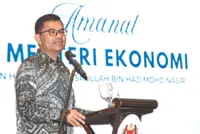Rice production in Mekong Delta in recent years has been stable at about 24 to 25 million tonnes, contributing over 50% of rice production and over 90% of rice exports from the country.
HANOI: A new project aims to form a stable and large-scale raw material area for rice production in the Mekong Delta, creating favourable conditions for modern and multi-purpose methods.
The project will sustainably develop one million hectares of high-quality rice with green growth in the Mekong Delta.
Already a subscriber? Log in
Save 30% OFF The Star Digital Access
Cancel anytime. Ad-free. Unlimited access with perks.





